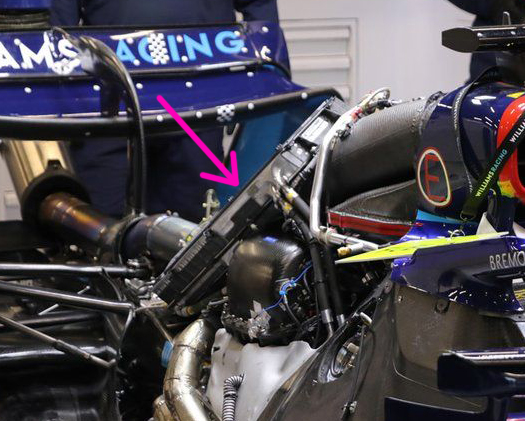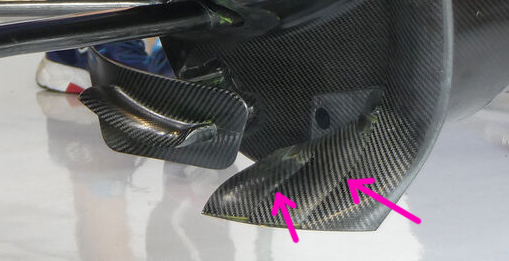
well lit rear view of the downwash approach the packaging has of the Williams




Similar tea tray/bow to the Red Bull, albeit on the slimmer side. Is anyone else using this design?AeroDynamic wrote: ↑24 Feb 2022, 10:45Tea tray and suspension
https://cdn-1.motorsport.com/images/mgl ... tail-1.jpg


As first guess, I'd think they're trying to run the vortex from the floor edge flap down under the floor and in to the vortex channel that runs just along the edge of the tunnel/diffuser and then direct it at the tyre squirt zone.

I'd say they're trying to shed the vortex outwards from the edge fence - then it looks like after the cutout there's quite a smooth ramp into the diffuser so maybe trying to stop a vortex forming on that edge and drawing more tyre wake into the diffuser?!Just_a_fan wrote: ↑26 Feb 2022, 14:29As first guess, I'd think they're trying to run the vortex from the floor edge flap down under the floor and in to the vortex channel that runs just along the edge of the tunnel/diffuser and then direct it at the tyre squirt zone.AeroDynamic wrote: ↑24 Feb 2022, 12:22floor detail ahead of rear wheels
https://imgr1.auto-motor-und-sport.de/A ... 876104.jpg
You're probably right.jjn9128 wrote: ↑26 Feb 2022, 18:29I'd say they're trying to shed the vortex outwards from the edge fence - then it looks like after the cutout there's quite a smooth ramp into the diffuser so maybe trying to stop a vortex forming on that edge and drawing more tyre wake into the diffuser?!Just_a_fan wrote: ↑26 Feb 2022, 14:29As first guess, I'd think they're trying to run the vortex from the floor edge flap down under the floor and in to the vortex channel that runs just along the edge of the tunnel/diffuser and then direct it at the tyre squirt zone.AeroDynamic wrote: ↑24 Feb 2022, 12:22floor detail ahead of rear wheels
https://imgr1.auto-motor-und-sport.de/A ... 876104.jpg
I wouldn't say that


Was thinking this could be thought of as a bypass duct. If this front exit duct is open, less air travelling through the main sidepod inlet moves through the radiators and sidepods generally (assumption). So, in cooler weather, they open up this bypass duct and reduce stagnation in front of the main inlet. In hotter weather, they close it to force all inlet air through the radiators. If they can tune it this way they wouldn't need to manufacture multiple engine cover geometries for different weather conditions, only change the relatively small 'bypass' panels on either side.CLKGTR wrote: ↑26 Feb 2022, 17:40Hi res shot of the sidepod (Photo: Pirelli / Williams, edited by: MAXF1.net)
https://maxf1.net/wp-content/uploads/20 ... XF1net.jpg